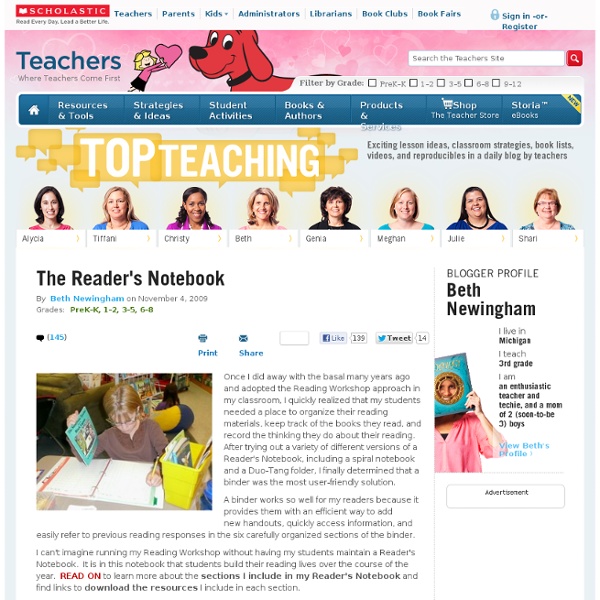The Reader's Notebook
Once I did away with the basal many years ago and adopted the Reading Workshop approach in my classroom, I quickly realized that my students needed a place to organize their reading materials, keep track of the books they read, and record the thinking they do about their reading. After trying out a variety of different versions of a Reader's Notebook, including a spiral notebook and a Duo-Tang folder, I finally determined that a binder was the most user-friendly solution. A binder works so well for my readers because it provides them with an efficient way to add new handouts, quickly access information, and easily refer to previous reading responses in the six carefully organized sections of the binder. I can't imagine running my Reading Workshop without having my students maintain a Reader's Notebook. It is in this notebook that students build their reading lives over the course of the year.
http://www.scholastic.com/teachers/top_teaching/2009/11/readers-notebook
Literature Circle Models
After experimenting for many years, I discovered an approach that's easy, fun, and effective. I refer to it as Classroom Book Clubs because it's a more relaxed method of doing Literature Circles that doesn't involve roles. You can view a narrated slidecast to this model by scrolling down to the Classroom Book Clubs section. On this page you can also learn about different types of Literature Circles.
Great Infographics for Language Teachers Part 1
Infographics are great learning materials. The colourful graphics, clear text and their size make them ideal for classroom integration. I have been posting some of the ones I deem educationl to help teachers leverage this resource to create engaging, relevant and personalized learning experiences in their classes.
Reading and Wriitng Notebook FAQ
I just started reading The Cafe Book yesterday by The Sisters and I am already so excited to make some changes in my classroom because of it. You can bet that I will be doing some serious posting about it during the next month as I begin to launch it in my classroom. I got a really great email from Lindsay today and thought I would answer her questions on the blog about my reading and writing notebooks.
Collaborative Literature Circles
Using edModo and iChat to jazz up Lit Circles into the 21st Century Welcome to our collaborate literature circles website. We used our cool new technology to twist literature circles into a new tech-ridden beast.
Reading and Writing Lessons Using Visual Art
37 Ways Teachers Can Use Pinterest In The Classroom
37 Ways Teachers Can Use Pinterest In The Classroom There are a lot of great technology tools out there for teachers that can make it easier to connect with other educators, get ideas for classroom activities, and find inspiration. One of the newest and best of these online tools is Pinterest, which has quickly become a favorite among educators. Using online “pinboards” teachers can save everything from photos to blog posts in one easily accessible and usable place. Educators who are curious about Pinterest should sign up for an invitation today (it’s still invite only, but it doesn’t take long to get an invitation) and start creating their own amazing collections of pins. Not sure where to start?
I.N.K.
Related:



